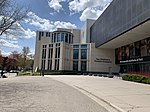Consulate General of Sweden, Minneapolis
The Consulate General of Sweden, Minneapolis was the diplomatic mission of Sweden in Minneapolis between 1963 and 1989. The consulate originated from the honorary consulate opened in 1908, which was converted into a vice consulate in 1934 and into a consulate general in 1963. Along with those in New York City, San Francisco, Montreal, Chicago, and Houston, the consulate belonged to the so-called "heritage consulates" due to the large number of inheritance cases it handled. The consulate's jurisdiction included not only the city of Minneapolis but also the states of Minnesota, Montana, North Dakota, South Dakota, and Wisconsin, and later also the states of Colorado, Wyoming, and New Mexico. The consulate closed in 1989, and from the same year, a Swedish honorary consulate general operates in Minneapolis with an unpaid honorary consul general as its head. Since 2003, the honorary consul general has also served as the CEO and president of the American Swedish Institute.
Excerpt from the Wikipedia article Consulate General of Sweden, Minneapolis (License: CC BY-SA 3.0, Authors).Consulate General of Sweden, Minneapolis
Park Avenue South, Minneapolis Phillips
Geographical coordinates (GPS) Address Website Nearby Places Show on map
Geographical coordinates (GPS)
| Latitude | Longitude |
|---|---|
| N 44.954606244538 ° | E -93.265771553271 ° |
Address
American Swedish Institute
Park Avenue South 2600
55407 Minneapolis, Phillips
Minnesota, United States
Open on Google Maps








